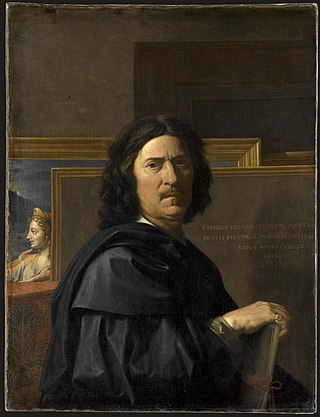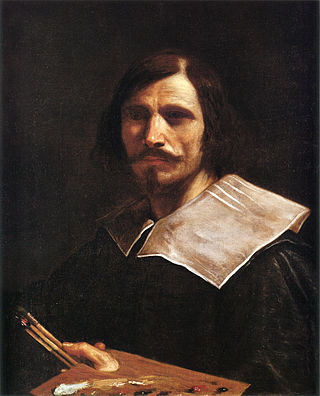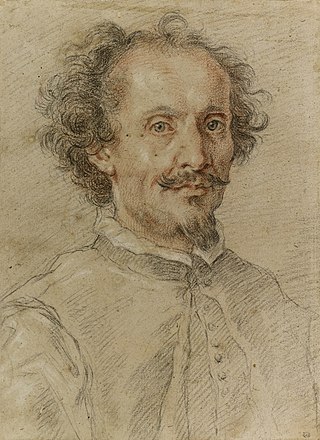See also
Gallery
- Aurantium corniculatum from Hesperides (1646)
- Alla lima citrata oblonga sive scabiosa et mostrosa from Hesperides (1646)
- Lumia ollulae aspectu from Hesperides (1646)
- Limon liguriae ceriescus from Hesperides (1646)
- Flos indicus e violaceo fuscus radice tuberosa from Flora, seu de florum cultura (1646)
- Narcissus indicus Liliaceus diluto colore purpurascens from Flora, seu de florum cultura (1646)
- Limon S. Remi from Hesperides (1646)
- Limon Caietanus from Hesperides (1646)
- Aurantium dulci cortice et Sinense from Hesperides (1646)
- Lima eadem rotunda from Hesperides (1646)
- Limon perettae consimilis from Hesperides (1646)
- Aurantium crispo folio from Hesperides (1646)
- Aurantium sicciore medulla hibernum from Hesperides (1646)
Related Research Articles

Nicolas Poussin was the leading painter of the classical French Baroque style, although he spent most of his working life in Rome. Most of his works were on religious and mythological subjects painted for a small group of Italian and French collectors. He returned to Paris for a brief period to serve as First Painter to the King under Louis XIII and Cardinal Richelieu, but soon returned to Rome and resumed his more traditional themes. In his later years he gave growing prominence to the landscape in his paintings. His work is characterized by clarity, logic, and order, and favors line over color. Until the 20th century he remained a major inspiration for such classically-oriented artists as Jacques-Louis David, Jean-Auguste-Dominique Ingres and Paul Cézanne.

Giovanni Francesco Barbieri, better known as (il) Guercino, was an Italian Baroque painter and draftsman from Cento in the Emilia region, who was active in Rome and Bologna. The vigorous naturalism of his early manner contrasts with the classical equilibrium of his later works. His many drawings are noted for their luminosity and lively style.

Francesco Maria Sforza Pallavicino or Pallavicini, was an Italian cardinal, philosopher, theologian, literary theorist, and church historian.

Francesco Barberini was an Italian Catholic Cardinal. The nephew of Pope Urban VIII, he benefited immensely from the nepotism practiced by his uncle. He was given various roles within the Vatican administration but his personal cultural interests, particularly in literature and the arts, meant that he became a highly significant patron. His secretary was the antiquarian Cassiano dal Pozzo who was also a discerning patron of the arts. Francesco was the elder brother of Cardinal Antonio Barberini and Taddeo Barberini who became Prince of Palestrina.

Cassiano dal Pozzo was an Italian scholar and patron of arts. The secretary of Cardinal Francesco Barberini, he was an antiquary in the classicizing circle of Rome, and a long-term friend and patron of Nicolas Poussin, whom he supported from his earliest arrival in Rome: Poussin in a letter declared that he was "a disciple of the house and the museum of cavaliere dal Pozzo." A doctor with interests in the proto-science of alchemy, a correspondent of major figures like Galileo, a collector of books and master drawings, dal Pozzo was a node in the network of European scientific figures.

The Diocese of Rimini is a Latin Church ecclesiastical territory or diocese of the Catholic Church in Emilia Romagna, Italy. From earliest times, it was a suffragan to the Holy See, despite repeated attempts by the Diocese of Ravenna to claim it as a suffragan diocese. Since 1604, however, it has been a suffragan of the Archdiocese of Ravenna-Cervia.

Mario Nuzzi, who went by the pseudonym, Mario de' Fiori was an Italian painter in the Baroque style. His paintings are all based around floral arrangements; hence the name Fiori (flowers).
The Catholic diocese of Sarsina was a Roman Catholic ecclesiastical territory in Emilia-Romagna, northern Italy, seated in Sarsina, in the province of Forlì, some 32 km south-southwest of Cesena. The diocese was founded in the 5th century, and was suffragan (subordinate) to the archbishop of Ravenna. The diocese existed until 1986, when it was united with the diocese of Cesena.

The Diocese of La Spezia-Sarzana-Brugnato is a Roman Catholic ecclesiastical territory in Liguria, northern Italy, created in 1929. It is a suffragan of the Archdiocese of Genoa.

The Diocese of Anagni-Alatri is a Latin Church ecclesiastical territory or diocese of the Catholic Church in Lazio, Italy. It has existed in its current form since 1986. In that year the Diocese of Alatri was united to the historical Diocese of Anagni. The diocese is immediately exempt to the Holy See.
The Pontificio Collegio Urbano de Propaganda Fide was established in 1627 for the purpose of training missionaries to spread Catholicism around the world.

Camillo Francesco Maria Pamphili was an Italian Catholic cardinal and nobleman of the Pamphili family. His name is often spelled with the final long i orthography; Pamphilj.

Giovanni Pietro Maffei (1533–1603), also anglicized as John Peter Maffei, was an Italian Jesuit and author. He wrote a life of Ignatius of Loyola, founder of the Society of Jesus, and also wrote about the activities of the Society in the Orient.

Anna Colonna (1601–1658) was an Italian noblewoman of the Colonna and Barberini families. She was also the Princess of Paliano.

The Diocese of Guardialfiera or Diocese of Guardia was a Roman Catholic diocese in Italy. The diocese was established in the second half of the 11th century, with seat of the diocese was located in the city of Guardialfiera in the Province of Campobasso in the region of Molise. In 1818, the diocese was suppressed, and its ecclesiastical territory was assigned to the Diocese of Termoli.

La finta pazza is an opera composed by Francesco Sacrati to a libretto by Giulio Strozzi. Its premiere in Venice during the Carnival season of 1641 inaugurated the Teatro Novissimo. It became one of the most popular operas of the seventeenth century.

Anna Maria Vaiani was an Italian engraver, who was most known for her botanical engravings and designs.

Vincenzo Leonardi was an Italian illustrator of natural history, who for some 20 years collaborated with Cassiano dal Pozzo (1588-1657), a prominent member of the Lincean Academy and noted art collector from Turin.

Agostino Mascardi was an Italian rhetorician, historian and poet.

Ludovico Settala was an Italian physician during the Renaissance.
References
- 1 2 3 4 5 6 Ceresa 1996.
- 1 2 Erickson, Robert F. "Giovanni Battista Ferrari". Missouri Botanical Garden. Archived from the original on March 3, 2016.
- ↑ Freedberg 1989, p. 19.
- ↑ Chalmers 1814, p. 236.
- ↑ Freedberg 1997, p. 41.
- ↑ Orationes XXV, Lyon (Sumptibus Ludovici Prost, heredis Rouille 1625), with a frontispiece by Johann Friedrich Greuter after Domenichino. Later editions include ones in Rome (Francesco Corbelletti), 1627; Rome (Typis Petri Antonij Facciotti), 1635, with a frontispiece by Francesco Cimi after Romanelli and three new orations; Venice (Apud Baleonium), 1644; Cologne (Apud Cornelium ab Egmont), 1650, with a frontispiece by Peter Paul Troschel after Romanelli (reversed); London (Ex officina Rogeri Danielis), 1657; and London (Ex officina Ioannis Redmayne), 1668.
- ↑ Orationes XXX - XXXIII. The fourth oration dealing with Hebrew issues is entitled Stylus Hebraicus. Sive in hostes brevitatis (Orationes, 1650, pp. 195-239; Orationes, 1657, pp. 148-180).
- ↑ Grand 1985, p. 6.
- ↑ Kew World Checklist of Selected Plant Families
- ↑ Gunn, Mary (1981). Botanical exploration of southern Africa : an illustrated history of early botanical literature on the Cape flora : biographical accounts of the leading plant collectors and their activities in southern Africa from the days of the East India Company until modern times. L. E. W. Codd. Cape Town: Published for the Botanical Research Institute by A.A. Balkema. p. 16. ISBN 0-86961-129-1. OCLC 8591273.
- ↑ Grand 1985, p. 7.
- ↑ Fountains, statues, and flowers: studies in Italian gardens of the sixteenth and seventeenth centuries by Elisabeth B. MacDougall (Dumbarton Oaks, 1994)
- ↑ Grand 1985, p. 22.
- ↑ "Hesperides sive de Malorum Aureorum cultura et usu", The Metropolitan Museum of Art
Sources
- Chalmers, Alexander (1814). "Ferrari (John Baptist)". General Biographical Dictionary . Vol. 14. J. Nichols. p. 236.
 This article incorporates text from this source, which is in the public domain .
This article incorporates text from this source, which is in the public domain . - Gardening Knife, from "Hesperides" by Giovanni Battista Ferrari Archived 2013-01-17 at archive.today
- Ferrari's book
- Antique Prints
- Ceresa, Massimo (1996). "FERRARI, Giovanni Battista". Dizionario Biografico degli Italiani, Volume 46: Feducci–Ferrerio (in Italian). Rome: Istituto dell'Enciclopedia Italiana. ISBN 978-8-81200032-6.
- Grand, Stanley Irwin (1985). Seven Allegorical Engravings from Giovanni Battista Ferrari's De Florum Cultura (Rome, 1633). University of Wisconsin-Madison.
- Freedberg, David (1989). "Cassiano dal Pozzo's Drawings of Citrus Fruits". Il Museo Cartaceo di Cassiano Dal Pozzo. Cassiano Naturalista, Quaderni Puteani. I: 16–36.
- Freedberg, David (1997). Francesco Solinas (ed.). "From Hebrew and Gardens to Oranges and Lemons: Giovanni Battista Ferrari and Cassiano del Pozzo". Cassiano dal Pozzo, Atti del Seminario Internazionale di Studi. Rome: De Luca: 37–72.
- Ferrari, Giovan Battista. "Flora overo Cultura di Fiori." 1638. Facsimile edition, Florence: Leo S. Olschki, 2001.
Reverend Giovanni Baptista Ferrari | |
|---|---|
| Born | 1584 |
| Died | 1 February 1655 (aged 70–71) |
| Nationality | Italian |
| Occupation(s) | Jesuit priest, orientalist, university teacher, botanist |
| Academic background | |
| Alma mater |
|
| Influences |
|
| International | |
|---|---|
| National | |
| Artists | |
| People | |
| Other | |












